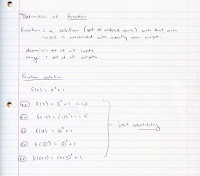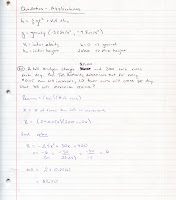Yesterday (Tuesday, Sept 15) and today, we have been reviewing the basic transformations (up, down, left, and right shifts, reflections, stretches and shrinks). In the homework, Tuesday night, I introduced some function composition (using x^2, |x|, 1/x, and Sqrt(x)).
Today in class, after reviewing the homework, students were put in groups and given a single graph to work on. Tomorrow in class, each group will present their graph and explain how they came up with it, hopefully convincing the rest of the class that they are correct.
This is a challenging exercise. I hope that you start to understand how to generate a graph of this sort, but it may take some time and practice.
There are no notes for yesterday or today.





























